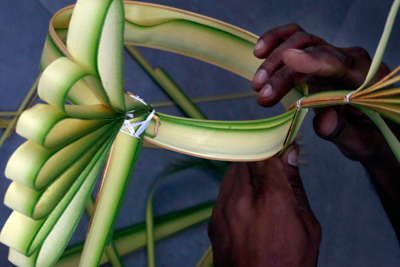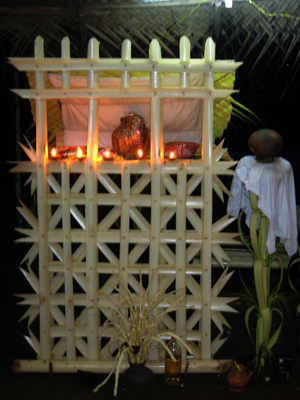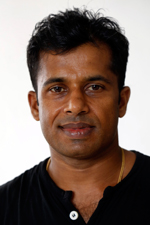Ritual and art woven in Gok

A quick demonstration on making a Kirula Thoppiya. Pix by M.A. Pushpa Kumara
Leaving the busy Pamunuwa Road in Maharagama behind, we take a side road to the home of Chaminda Mahawattage and as we enter the sitting room what catches the eye is something different and unique.
A beautifully and intricately carved Gok Gediya (a pot made of tender coconut fronds).
On that rainy morn last Tuesday, we have walked in as Chaminda, with his tool box with different knives and implements by his side, is adding the finishing touches to the Gok Gediya, from the heart of which comes a kehel bade (banana pith).
These are gok ornaments along with poruwa structures that Chaminda crafts for weddings, but we are here to discuss his art in connection with all that is gok linked to rituals and customs, from time immemorial.
For Chaminda, the lure of the gok kalawa came simultaneously with his passion for low-country dance while still a boy in his village of Karandana in the Ratnapura district.
As he learnt the intricate steps and hand movements from Guru Jayalath Seneviratne, each and everything accompanying this art form he picked up as well, among which was the gok kalawa.

A Pahan Pela
Chaminda who began his dance career in the National Youth Services Council’s dance troupe from 1997-99, is now part of the state dance troupe of the Cultural Affairs Ministry, travelling across the world. He has also developed his own style of gok crafts, drawing inspiration from what has gone before him but adding through his innate skill a touch of innovation to suit modern times. He mixes and matches fresh flowers such as nelum and olu with his gok creations.
It is, however, gok as a traditional but dying art that we dwell on and Chaminda creates images of the vital role played by gok-kola in Shanthikarma, a ritual performed to bestow divine blessings including good health.
To perform a Shanthikarma, gok-kola, banana bade and kohomba leaves of trees with medicinal value are used, says Chaminda, picking out the Gara Yakuma Shanthikarmaya, where the sick person is blessed with a sheaf of mango leaves, kohomba leaves or burulla leaves.
“Gok leaves have special healing powers and an ability to absorb germs and this is why the pirith mandapa (hut-like structures from which Buddhist monks chant stanzas of Dhamma for protection and blessings), are made of gok-kola,” he points out. This is also why people are advised not to dismantle the pirith mandapa for at least thun waruwak or 1½ days.
There are inextricable bonds between the three main traditions of Udarata, Pahatharata and Sabaragamu dances with all the rituals of healing, Chaminda explains, adding that the Kohomba Kankariya which is a Shanthikarmaya forms part of the Udarata natum. The Pahatharata natum has the three traditions of Bentara, Matara and Raigama of which Raigama has links with the Devol Madu Shanthikarmaya.
He takes us through the unique gok designs of each of these traditions. When a Shanthikarmaya starts, the Devol Maduwa (the arch-like structure) made of gok leaves is thoroughly cleaned in ‘Madu Pe Kirima’ in honour of the coming of the deities to bestow blessings.

Chaminda Mahawattage
Usually, the Devol Maduwa is for the four important Gods — Vishnu, Natha, Kataragama and Pattini, with the main Thorana made of gok-kola, banana strips and habarala leaves being dedicated to Goddess Pattini, the patroness of motherhood, fertility and health, he says.
Next, he focusses on another segment dubbed ‘Hende Samayama’, a ritual to appease the five demons of Bali Kaama, Bili Kaama, Honthu Kaama, Pulutu Kaama and Rathi Kaama by making specific offerings such as elegant décor, a rooster, incense, certain foods including meat items and dance respectively, to ward off the evil besetting the victim.
We are told about the Pita Warala combined with a mask, made of thinly shredded gok leaf which is used for the Gara Yakuma Shanthikarmaya and the Kirula Thoppiya or gok-kola headdress, a dance accessory used in a Devol Madu Shanthikarmaya.
Pahan Pela which have flickering oil lamps, flowers and incense are also significant in rituals and whenever a monk is invited to a home for a religious ceremony, a gok-leaf mat is laid for him to walk on, as it is considered to be pure.
Is it a dying art, we ask him and he replies that he thinks so……because creativity in gok should come from within a person.
“As a boy I was curious about gok craft and watched closely when Gurunnanses performing Shanthikarma created gok marvels. I watched and learnt the techniques. The art was not driven by money back then, it was more interest in the art itself,” he adds.
| Guru Gedera: Fostering pride in what is ours | |
| Gok artist Chaminda Mahawattage will show off his craft from August 30 to September 2 at the ‘Guru Gedera’ to be held at the Chitrasena Kalayathanaya at Narahenpita for which the countdown has begun. In early July, gathered at the kalayathanaya were several Gurunnanses to accept invitations from the Chitrasena-Vajira Dance Foundation, while workmen were busy setting up huts in the garden, for the Guru Gedera Festival, believed to be a first in Sri Lanka. While veteran dancing couple Chitrasena and Vajira’s granddaughter Heshma is the Director of the Guru Gedera Festival, daughter Upeka and granddaughters Umi and Thaji were hovering around the Gurunnanses attentively, having first paid obeisance and then guiding them to their seats. It is in celebration of the 75th year of the kalayathanaya that tribute will be paid through the Guru Gedera Festival to all who have contributed to taking traditional dance to the heights it has achieved. The four-day festival will feature Gurunnanses who are renowned for their traditional art forms, says Festival Manager Shanthini Shanmugarajah, adding that they hope it will provide a platform to bring the younger generation closer to these veterans. It will focus on the three main styles of Sri Lankan classical dance: The Kandyan dances (Uda-rata natum); the low-country dances of the southern plains (Pahatha rata natum); and the Sabaragamuwa dances, says Shanthini, adding that dance as an ancient art form has been nurtured with devotion and performed with reverence, accompanied by the melodious strains of the flute and vibrant drum-beats. “The origins of the Kandyan dances are believed to lie in an exorcism ritual – Kohomba Kankariya – performed to invoke blessings from God Kohomba while the low-country dances are performed to appease spirits which are said to cause sickness and the Sabaragamuwa dances relate to the worshipping of God Saman,” she elaborates. The Guru Gedera Festival is set to showcase puppetry; low-country traditional costumes or ‘thelme’ dance costumes; Kandyan dance costumes; drum-making; gokkola craft; traditional masks; and ‘innovation’ in keeping with modernity but not sacrificing tradition in both the traditional dance costumes and the traditional forms of drums. The festival will be inaugurated with the ritual of the ‘Pahan Maduwa’ with dance performances in the glow of lit-lamps. There will be interaction with the Gurunnanses in the different stalls, dance demonstrations, discussions, workshops and cultural performances. All those who walk into the kalayathanaya throughout the day will be provided traditional sweetmeats like kevum, made on the spot by ammes and steaming cups of tea.
|


